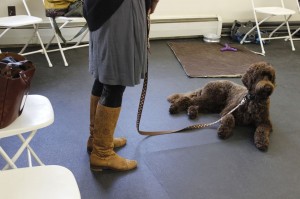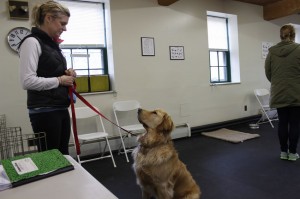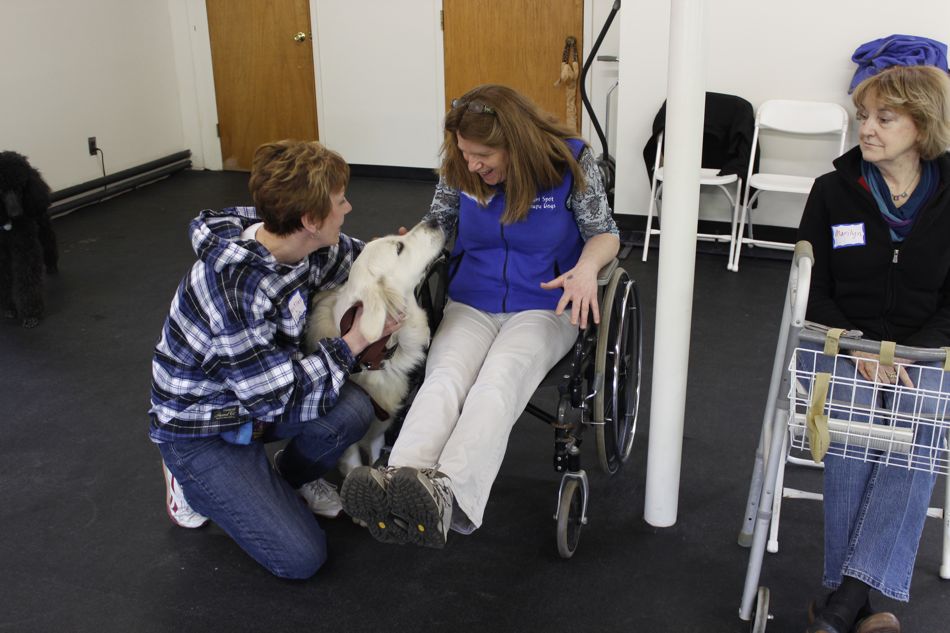We started another FULL Bright Spot Therapy Dog Training Course today at True Blue Dog Training. Several people traveled quite a distance from north of Boston to join us. True Blue is conveniently located on Rte. 9 in Haydenville, about 5 miles west of Northampton, making it easy for people traveling from all directions.
 Today’s group shows much promise. For starters, all of the dogs displayed wonderful, friendly, outgoing personalities, an essential requirement for a Therapy Dog. I encourage people to arrive 10-15 minutes early to give their dogs an opportunity to become acquainted with the training facility and start to settle in for our work session. I advise people to do the same on the day of their evaluation. Arriving at the last minute, puts the dog at a disadvantage and neither dog or handler settle in properly . Our dogs today were a very mellow bunch. Their handlers had brought beds for them to relax on and all were settled in and ready for business at precisely 10:00 a.m.
Today’s group shows much promise. For starters, all of the dogs displayed wonderful, friendly, outgoing personalities, an essential requirement for a Therapy Dog. I encourage people to arrive 10-15 minutes early to give their dogs an opportunity to become acquainted with the training facility and start to settle in for our work session. I advise people to do the same on the day of their evaluation. Arriving at the last minute, puts the dog at a disadvantage and neither dog or handler settle in properly . Our dogs today were a very mellow bunch. Their handlers had brought beds for them to relax on and all were settled in and ready for business at precisely 10:00 a.m.
I love meeting the prospective teams and hearing about their plans for visiting. One man with a handsome young black Lab, works at a school for troubled children. His dog Louie already visits the school informally with his handler a couple of times a week. After he becomes certified as a Therapy Dog, his handler would like his visits at the school to be made on a regular basis. Another handler is an integrative art teacher who would love to integrate her Therapy Dog Jaya into her teaching program. Everyone has a different and special reason for doing Therapy Dog work with their canine companion. All wish to share their sweet, friendly dog with others.
In the beginning portion of the course, I stress the importance of having basic obedience commands solidly in place – not just in one’s home or in the training center, but out in a public environment with lots of people, noises, smells, and other distractions. A Therapy Dog MUST Heel at his handlers’ side, MUST Sit Stay and Down Stay on command wherever he goes. This, I explain, is vital to having a pleasant visiting experience in a facility. After temperament checking, basic commands are the next thing to be checked in the formal evaluation of a Therapy Dog.
Using the nursing home environment as the teaching model, I instruct handlers in the proper way to greet, interact, and depart with their Therapy Dog when visiting an elderly person. Teams are introduced to mock patients in a wheelchair, with a walker, and simply sitting in a chair. Class size is deliberately kept small, enabling all teams to get plenty of practice. The beginner and advanced portions of the 2-part-workshop-style course are scheduled two weeks apart, offering handlers time to practice the skills we will build on in part 2. I’m looking forward to seeing this great group of dogs and handlers again on April 28th.
